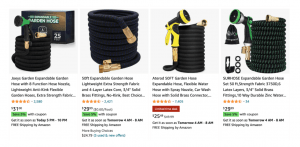How To Outsmart Your Competition On Amazon FBA
Whoever said there’s nothing wrong with a little healthy competition clearly wasn’t an Amazon FBA seller — it’s tough out there. And with more sellers entering the market everyday, sometimes it feels impossible to get ahead of the competition.
But with the right strategy, the right tools, and the right advice, outsmarting your competitors is a cakewalk. Here’s what you’ll learn inside:
- Identify your competitors
- Track your competitors
- Adjust your strategy
- Outsmart your competition in Amazon today
- Free resources for Amazon FBA sellers
Step 1: Identify your competitors
You can’t outsmart your competitors if you don’t know who they are. So before you do anything else, head over to Amazon and start searching for them — here’s how:
- Open Amazon
- Type in keywords related to your product
- Filter the results by department, features, price, reviews, and so on
The point is to narrow down the search results until there are only a few major players left. And the remaining products should be very similar to yours. This identifies your direct competition — or the brands that share key characteristics like your:
- Product
- Audience
- Price points
For example, if you sell expandable garden hoses at $30 per unit, your direct competitors might look like this:

Pro Tip 💡
If you don’t want to search for competitors by hand,
try using an app or browser extension like Zoof.
Either way, you’re going to need a list of your direct competitors (with links to each product!) so you can keep an eye on them.
Step 2: Track your competitors
For this step, you’re definitely going to want an app or browser extension. We recommend Zoof again because it’s got literally everything you need to sell on Amazon (it’s not limited to just competitor research tools). But you can also use Ahrefs, MerchantWords, and so on — whatever works best for you.
Regardless of which platform you choose, go back to your list of direct competitors. Plug one of them into the tool you’re using and record these data points:
- Top-performing keywords
- Search volume (and volume history) for each keyword
- Listed price per unit
- Product rating (one star, two stars, etc.)
- Sales and revenue
Pro Tip 💡
Reserve ASIN lookup is the easiest way to do this.
Collect the data above for each direct competitor. As you go, take note of anything unique about the products your competitors offer. For example, a competitor may carry an additional color variation or provide special sizing options.
Step 3: Adjust your strategy
After you’ve collected competitor data, it’s time to analyze it. Answer the questions below to start uncovering insights:
- Which products have high-performing keywords? What are those keywords?
- Which products have the highest search volume?
- Which products have the lowest cost? The highest?
- Which products have the highest rating? The lowest?
- Which products have the highest sales and/or revenue?
As you answer these questions, be on the lookout for patterns. The key here is finding out what your competitors are getting right, and what they’re getting wrong, so you can adjust accordingly.
For example, let’s say a competing product (garden hose) has high-performing keywords. But the product also has few sales and poor reviews. You review their product page and notice the following:
- Cost per unit is $3 higher than the industry average
- Reviews praise the garden hose color selection
- Reviews critique the packaging (too much cardboard)
Here’s how to break it down:
| What your competitor got right |
What your competitor got wrong |
How to use this to your advantage |
|
|
|
Now, if you’re not in a place to make serious product changes (like changing the packaging or adding new colors), there are other ways to pivot.
Use long-tail keywords
The closer someone is to buying something, the more specific their search terms get. These are called long-tail keywords and here are some examples:
| Regular Keyword | Long-Tail Keyword |
| shorts | plaid shorts for women |
| hose | ten foot green garden hose |
| bike | stationary under desk bicycle |
Use your Amazon tool to help identify long-tail keywords. Even though they get less traffic than regular keywords, they’re just as valuable (if not moreso). This is because long-tail keywords target customers who are towards the end of the buying journey — they’re ready to make a purchase.
- Incorporate long-tail keywords into your Amazon product listing
- Make sure keywords appear naturally in the text (avoid stuffing)
- Use long-tail keywords that are relevant to your product
Set pricing alerts
If you sell a product that’s highly competitive, try pricing out your competitors. First, set up alerts in your Amazon tool to notify you when competing products change price (Zoof can do this for you).
Then when you get an alert, check the new price and note whether it went up or down. And price your product just below the competition. When customers compare their options, if all else is equal, they usually choose the product that’s more affordable.
Outsmart your competition on Amazon today
Whether you’re a new seller or you’ve been in the FBA game for years, there’s always a way around your competitors. Here’s a recap of how to build an effective, competitive strategy:
- Identify your competition on Amazon
- Track your competitors and analyze their data
- Use what you learn about them to win 🏆
Don’t let your competition steal your hard-earned sales. Instead, beat them to the finish line by exploring all our free Amazon FBA resources. Check out our guides, profit calculators, and online courses to get ahead today. What are you waiting for?
Free resources for Amazon FBA sellers
Find your first--or next--product to sell fast
Discover top-selling products on Amazon. See accurate sales trends and profit estimates so your next product succeeds. Plus, plan out your entire product and brand with a new custom AI tool unavailable anywhere else.
Heading 1
with a request body that specifies how to map the columns of your import file to the associated CRM properties in HubSpot.... In the request JSON, define the import file details, including mapping the spreadsheet's columns to HubSpot data. Your request JSON should include the following fields:... entry for each column.


